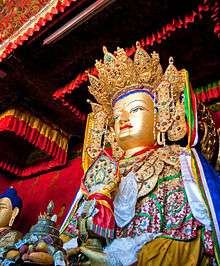Jowo (statue)
Jowo Shakyamuni or Jowo Rinpoche (Wylie jo bo rin po che) is, with Jowo Mikyö Dorje, the most sacred statue in Tibet. Jowo Rinpoche is housed in the Jokhang temple and Jowo Mikyö Dorje in the Ramoche temple in Lhasa.

History
The Jowo Rinpoche statue has a long history and is said to have been personally blessed by the Buddha. It came to be owned by the king of Magadha, who gave it to a Tang emperor of China. One of the emperor's clansman's daughter, Wenchen Kongjo took it to Lhasa via Lhagang in a wooden cart when she married King Songtsen Gampo. During Mangsong Mangtsen's reign (649-676), because of a threat that the Tang Chinese might invade, Princess Wencheng is said to have hidden the statue of Jowo Rinpoche in a secret chamber in the Jokhang. Princess Jincheng, sometime after 710 CE, had it placed in the central chapel of the Jokhang. It was replaced at Ramoche by a statue of Jowo Mikyo Dorje, a small bronze statue of the Buddha when he was eight years old, crafted by Vishvakarman, and brought to Lhasa by the Nepalese queen, Bhrikuti. Jowo Mikyo Dorje was badly damaged by the Red Guards during the Cultural Revolution.[1][2]
The Ramoche temple was gutted and partially destroyed in the 1960s and the bronze statue disappeared. In 1983 the lower part of it was said to have been found in a Lhasa rubbish heap, and the upper half in Beijing. They have now been joined and the statue is housed in the Ramoche Temple, which was partially restored in 1986,[3] and still showed severe damage in 1993.
The restoration of the Jowo was possible thanks to Ribur Rinpoche (1923–2006), a revered Lama who was jailed by the Chinese Army in 1959 for 20 years in Lhasa and was released in 1979 in connection with the liberalization politics of Deng Xiaoping. Ribur Rinpoche was granted a position at the Office of Religious Affairs of Tibet and began attempts to bring back spiritual sacred treasures that had been taken to China. In 1983, with the help of the 10th Panchen Lama, he succeeded in finding the upper part of Jowo Mikyö Dorje and returned it to Tibet. The Panchen Lama explained to the Chinese government how sacred the value of Jowos was for Tibetans and that their response to the quest of Ribur Rinpoche would help to prove the sincerity of the new Chinese religious policies.[4][5]
References
- Dorje, Gyume (1999), p. 92. Footprint Tibet Handbook with Bhutan. Footprint Handbooks, Bath, England. ISBN 0-8442-2190-2.
- Tibet (6th edition), p. 104. (2005) Bradley Mayhew and Michael Kohn. Lonely Planet. ISBN 1-74059-523-8.
- Dowman, Keith. 1988. The Power-Places of Central Tibet: The Pilgrim's Guide, p. 59. Routledge & Kegan Paul. London. ISBN 0-7102-1370-0 (ppk).
- Ribur Rinpocheis no more, His Story Remains with Us Archived 2011-06-09 at the Wayback Machine
- Preface and Short Biography
Literature
von Schroeder, Ulrich. 2001. Buddhist Sculptures in Tibet. Vol. One: India & Nepal; Vol. Two: Tibet & China. (Volume One: 655 pages with 766 illustrations; Volume Two: 675 pages with 987 illustrations). Hong Kong: Visual Dharma Publications, Ltd. ISBN 962-7049-07-7; Jo bo Rin po che («jowo rinpoche»): pp. 154, 158, 406, 407, 520, 672, 679, 686, 696, 711, 718, 726, 737, 792, 914, 918, 926–929, 1238; Fig. XII–11; Pl. 215A–C.